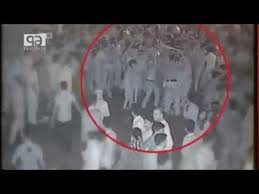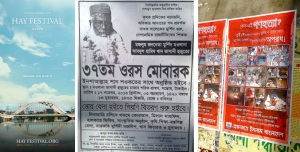By Seema Amin
“The ‘they,’ as it were, can constantly have ‘them’ invoking it…”— Heidegger
Easy does it. ‘They’ did it.
In ‘To kill a mockingbird,’ Harper Lee described the subjectivism of human experience: People generally see what they look for, and hear what they listen for. Justice, in this worldview, tends to ‘black out’, losing consciousness to a kind of societal tunnel vision. Atticus Finch, protagonist in that American classic, saw mockingbirds as epitomes of harmlessness, innocent songbirds that should not be prey to the predator. But in the natural world, mockingbirds are characterized by quite another ‘gift’. Mockingbirds mimic other birds. The song of the mockingbird is a song of the average, a kind of adjusted polyglot’s mean of birdsong…
The culture of ‘public reaction’ in Bangladesh today is an echo chamber of mockingbirds, not too distant from the cultures of resistance/s. The same coterie, friends, networks, who ‘resisted’ together for forty years resist on. They sign together, dine together, sing and fight together. Yet around them the ‘culture’ of corruption—the three muskateers of political, social, sexual corruption–has not changed terrifically, much as the colors of our national holidays remain heroically the same, strutting ‘freedom’, tradition, and ‘progressive liberal values’ all at once, singing the song of the average.
Heidegger’s treatment of the ‘They’ in Adorno’s The Jargon of Authenticity, plumbs the concept of ‘averageness’ in a culture of exchange: ‘Being-with-another’ concerns itself with averageness…Thus the ‘they’ maintains itself factically in the averageness of that which belongs to it, of that which it regards as valid and that which it does not, and of that to which it grants success and that to which it denies it… This care of averageness reveals in turn an essential tendency of Dasein which we call the ‘leveling down’…of all possibilities of being.” Complex as it sounds, Adorno makes this concept concrete when he describes a world born of phrases, chatter, giving birth to a ‘reality that arose in the name of culture.’
A few days after the coordinated public ‘humiliation’/molestation/ dare I say—rape– of more than twenty women in Dhaka University’s TSC, Information Minister Inu described the style of the ‘attack’ as ‘Talibaneque.’ It would take the Taliban of course, or Isis, or, at the very least, Ansarullah Bahini, to get away with—ehm–this crime of ‘no name’ that Rahnuma Ahmed, in 2010, named in an article entitled, “Chatra League and sexual violence, A wide spread state of denial,” after incidents of sexual harassment in the same Raju Chottor area in Pahela Boishakh. In 2015, of course, it would take the Taliban. And this, though the security is beefed up more each year, audibly to stem any miniscule threat of ‘militancy’, cultural harassment, etc. We heard the same stories of extraordinary security measures, special RAB and police booths as in Ekushey and Boi Mela, when blogger Abhijeet Rai was silenced forever. And yet, in spite of everything, the same exact venue remained ‘outside of the jurisdiction’ of security. No surprise. They—the Taliban– control Shahbagh after all. They won the spoils of that war in 2008. They mark their territory, we circle in their piss. They came from underground terrorist tunnels behind TSC, they were handed over by Nandi to the police, who, in turn, were so enamored with the most wanted terrorists of Bangladesh that they released them, did not even take a second glance at the now famous ‘bearded man’ seen repeatedly near the scene on the cameras…Beards get alarming only in the aftermath. But of course! The terrorists control Shahbagh.
In spite of detailed reports in the print media immediately after the incident, recounting sexual harassment in Jagannath by Chatra League on the same day as the spectacle at TSC, the TV media mediated an Islamic threat soon after, reporting what could well be a clue, or a red herring, that the state’s mouthpieces were only to eager to echo. Meanwhile, the weight of the ‘evidence’ veered towards the song of the average. Women’s rights activists, university professors, writers, even students, seemed caught between explaining the endemic environment of sexual harassment and ringing the alarm bell over a threat to the national (secular) culture of Pahela Boishakh. Exceptions to note: some referred back to the pages of history, the 1998 protests over serial rape by Chatra League cadres in Jahingnagar University; some hinted at the political patronage that creates impunity. But the echo chamber, where the mockingbirds flocked quickly, swiftly sang the song of the Rooster of the morning after, who announced with alarm the usual, and yet, unusual suspects. Chatter flits between half truth and an incomplete lie.
In a thorough report in the Dhaka Courier (24 April) the culture of impunity in rape and sexual harassment prevalent even in ’73 is mentioned, alongside the historical marker of ’71 regarding rape. Afsan Chowdury’s purported claim that the destigmatization of rape was ‘the most significant’ legacy of Pakistan, that the ’71 breakdown of norms regarding public rape allowed impunity regarding rape to become the norm, is intriguing; Bangladesh, however, did not merely continue impunity for Pakistani and razakar rapists, they gave impunity for rapists from our own freedom fighters. War has always involved rape and the notion that it takes such a violent ‘breakdown’ for the patriarchal norms in peacetime to change should raise some questions. In any case, today if we continue to thank Pakistan for the ‘destigmatiziaton’ of pubic rape we may as well blame patriarchy and its normalization of sexual violence on Pakistan in independent Bangladesh. Afsan Chowdhury himself is quoted elsewhere saying that power and privilege provides impunity to rapists; and has that power not changed hands? Only from man to man, state to state, old patronage, new patronage. Merely.
The report’s own description of Chatra League’s shame provides some clue: “DMP Joint Commissioner Munirul said they were working on releasing the suspects’ photos taken from screenshots of the footage. But in a related development, popular website Moja Loss had to wrap up their social awareness work done through the site after using the CCTV footage to identify some of the perpetrators and providing links to their Facebook pages. Many of the identified louts were found to be members of the Bangladesh Chhatra League, the student wing of the ruling party.”
The same report mentioned Chatra Union Dhaka University unit’s president Liton Nandi’s witness of men who were saying “record this Record this! We will never get such a view again.” Ironically, the ‘view from camera 16”, the one camera from which footage has not been released but which was placed in the area where the more ‘nameless’ acts occurred, may well also never be the same again. It is easy to doctor footage once so much time has passed. And given the way the security forces and state has reacted so far, a state so willing to ‘set the record straight’….one can, I suppose, only believe our authorities ‘innocent until proven guilty.’ Alas, still, the footage needs to be released, if only for us to know the full extent of what Rahnuma called a ‘nameless crime.’ The New York times live website recently did an article on “Sunitha Krishnan, the woman who made the bold and controversial move of posting real footage of men raping women on the Internet” and how it led to the identification of rapists following the 2012 New Delhi rape, among other cases.
Rahnuma Ahmed, in the 2010 article, ventured that the widespread ‘state of denial’ regarding Chatra League’s involvement in rape was slowing shaking. Did it? Has it? Does the crime have a name? In spite of commendably large, widespread and energetic protests following this year’s event, the chatter in the echo chamber seems to fall squarely in the center of the cesspool of events of the last few years where impunity has prevailed, and where, on the occasion someone is indicted the public largely remains skeptical that the actual criminals were found.
For so many reasons, my suspicions are with the most likely suspects, not the usual suspects, given the weight of history, the precedents of 2010, the particular style and nature of the assaults and the simultaneous assaults in Jagannth University on the same day, and the reining in of Chatra League’s women by the party following their desire to protest the incidents; and, and, and. But I maintain reasonable doubt. I ask myself, if an Islamic militant wanted to make a point with this coordinated lechery, what is the point ‘they’ would make? I know the mockingbirds’ answer: To intimidate those who practice ‘Bengali culture.’ But I get lost in irony. Point: Today, like every day, women are subject to public and private abuse simply because of the fragrance they carry of ‘womanhood.’ That fragnance is ‘apparent weakness.’ The same fragrance for which the police were emasculated by our valiant Chatra Union protestors when they came with bangles and sarees to Shahbagh thana. What point, then, was Chatra League making in Jagannath? What point were they making in hundreds of cases of assault that they have been implicated in over the years? Which Islamic force incited them, were they trying to suppress our ‘national culture’? What point were they making when their own female members wanted to protest? And were they making similar points when they extorted Jatra’s Anusheh over a concert, and failing to convince her, incited the conservatives of a village in Sundarban to rise against improperly covered women? But the media barely mentioned the connection. Some media, in fact, were found to be involved in the extortion. And how am I to separate the point they were making from the chatter: our famous actresses and activists vociferously muddling the waters so the dogs of Shahbagh can maintain jurisdiction– the one the police can quite honestly claim was not theirs— forever.
Friends, sisters, aunties, mockingbirds. The boy who cried wolf will one day face a real wolf. And that day, the wolf won’t spare any of us, not women, not minorities, no one. Just like we didn’t spare them. Though they hid in the jungle, as harmless as Lee’s innocent birds, the day our tigers roamed free, preying without fear, with the help of our mockingbirds. The dogs of Shahbag mark their territory and we circle in their piss. We sing songs of awakening. But no one wakes up in an echo chamber. Like the vuvuezla that deadens ours sense of sound, the sound of a ten year old screaming, being bitten, thrown, the obfuscations of the mockingbirds make obfuscation of the state unnecessary. And the show goes on.





Recent Comments